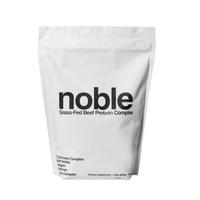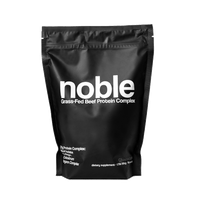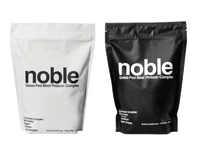This Size of Chicken Has Increased Almost 400% Over the Last 50 Years.
Share
Here is what this means for your health. It's no exaggeration to state that the US is obsessed with chicken. Each year:

We eat 26 billion pounds of chicken. We spend almost $30B on broiler chickens to eat. We have an inventory of 518 Million chickens.
The average American eats 65 pounds of chicken alone.

However, the chicken we eat today is very different than what our grandparents grew up eating.
Modern chicken is notorious for being "dry, "bland," and "flavorless." You typically need to fry it, overly season it, or marinate it in sauces and dressings to increase the flavor.
Contrast this to the 1960s, where chicken was considered a delicacy.
Famed Chef Julia Child had this to say about chicken:
"Chicken should be so good in itself that it is an absolute delight to eat as a perfectly plain, butter roast, saute or grill."

This begs the question: How did we end up with these fattened, flavorless birds that are dirty and pumped with hormones?
Enter the Chicken of Tomorrow Contest.

In the 1940s, Chicken was expensive and reserved for very special occasions. In 1948, the average chicken cost $3.
Which is $30 per bird adjusted for inflation. Wildly expensive.
During WWII, Red Meat was rationed and Americans doubled the amount of chicken they ate as a result.
Howard "Doc" Pierce, the National Poultry Director at A&P, was worried that the increased demand for chicken would decrease and A&P's poultry sales would come crashing down.
A&P, the country's largest Supermarket at the time, saw that this contest could do 2 things for them:
- Create a cost-efficient bird for future production
- Be a genius PR stunt and increase the marketing of their brand
As you saw in my first tweet, the Chickens of the early 1900's were vastly different birds that the chickens of today.
The average broiler chicken in the 1940s was around 3 pounds and it took a few months to get to that size.

Pierce ingeniously discovered a solution to his chicken issue. He decided to have A&P sponsor: "The Chicken of Tomorrow Contest."
This contest challenged competitors nationally to grow the fattest chickens in the shortest amount of time.
The rules of the contest were simple: Each contestant raised their special breed of chicken for 12 weeks. The birds would then be slaughtered and judged.
The judges key metrics were size, skin, width of the breast, and average weight. NOT TASTE.

There were two breeds that dominated the competition:
- Arbor Acres White Rocks' white feathered birds flourish in the "purebred" category
- Red Cornish Crosses from the Vantress Hatchery outperformed all in size, width, and weight.

These two birds would cross-breed to create the Arbor Acre Breed, whose Franken-genetics still dominate the chicken we eat today.
We are still eating the Chicken of Tomorrow and have continued to get even more "efficient" at creating our chicken product.
The average chicken broiler grows in 35 days, half the time of the fastest chicken in 1948. Our birds are also much fatter, averaging 6.5 pounds.

Our chickens are now so fat that they waddle when they walk. They have short legs and massive breasts that impair the mobility of the bird.
We have created genetically modified Frankenbirds that are created to get as fat as possible.
In addition to this, we are basically eating gigantic baby birds. For centuries, it has been known that a mature, adult bird is what creates the best flavor.
In the early 1900s, chickens would be slaughtered around 4+ months. Today's broiler is getting slaughtered at 47 days.

This is literally a 4X reduction in the age of the bird we are eating, which is responsible for the bland flavoring of today's bird.
Remember, we are talking about efficiency to create the most profit here.
The quicker you can slaughter the bird, the more $ you can make.

It is also important to note that what chickens are now fed is drastically different for what they have been eating evolutionarily.
Chickens are meant to eat a wide range of items such as: grass & bugs, scraps, mice, frogs, etc. They are kept around farms to clean up scraps!

Contrast this to today, where chickens now are primarily fed corn & soy with the sole intention to get them fat as quickly as possible.
Carbs are now the sole focus of the Chicken's diet, which we refer to as the "High-Energy Diet." Hint: This also works with humans.
These poor nutritional inputs are evolutionarily inconsistent from what chickens are meant to eat and also have created a weak-tasting bird.
@CarniClemenza Expands on this in his incredible thread on how our taste-buds have been manipulated by Big Food.
We the consumer, are the ones that ultimately suffer from this. Conventional Grain-Fed birds have an Omega-6 to Omega-3 ratio that can be as high as 17:1.
Contrast this to a pasture-raised chicken, which has an Omega 6 to Omega-3 ratio of 6:1.

The good news, is that there are still a number of great farms that breed & sell chickens the way they were supposed to be prior to 1948.
I recommend exclusively sourcing your chicken from a farm, where you can ensure the utmost quality of the bird.
A good farm will have the chickens moving out in the pasture, consuming wide ranges of items.
Buying from a farm will allow you to directly ask the farmer questions about how the bird was raised.

You will be paying a bit more, but the taste and nutritional density of the chicken will be worth it.
As you can see, our Chicken has been industrialized just like the rest of our food system.
I firmly believe that you and your family have a god-given right to the best quality animal protein possible.
If you want to see me breakdown more Animal-based nutrition hit the follow button @MrSollozzo and @carniclemenza and subscribe to our newsletter.



